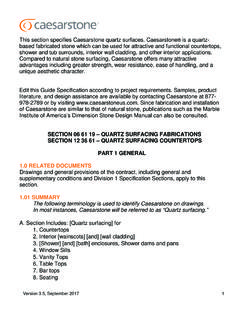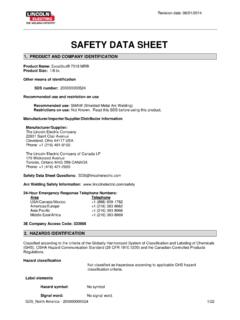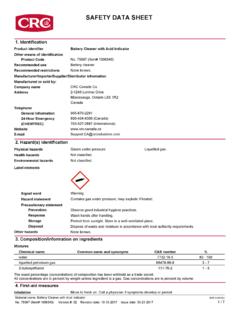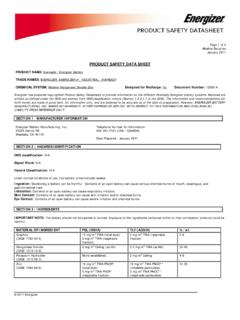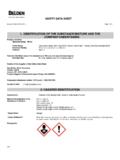Transcription of SAFETY DATA SHEET - Caesarstone
1 SAFETY data SHEET Page 1 of 13 Product Name: Caesarstone SDS Revision Date: December 2016 Product Use: Caesarstone quartz surfaces are designed for indoor use, particularly kitchen and bathroom worktops, flooring, cladding and other similar uses. Avoided Uses: Do not fabricate the product by using dry processes which generate dust. Company Address Emergency Phone # Caesarstone Ltd. MP Menashe, 38805, Israel +972-4-610-9368 Caesarstone USA Inc. 9275 Corbin Ave., Northridge, CA 91324 +1-818-779-0999 Caesarstone Canada Inc. 8899 Jane St., Concord, Ontario, Canada L4K 2M6 +1-416-322-4000 Caesarstone Australia Pty Ltd. Unit 3/1 Secombe Place, Moorebank 2170, NSW, Australia +61-1300-119-119 Caesarstone South East Asia Pte Ltd. 10 Bukit Batok Cresent, #08-06, The Spire, Singapore 658079 +65-6316-1938 Caesarstone (UK) Ltd.
2 Unit 3, Navigation Park, Enfield EN3 4NQ +44-800-1588088 2. HAZARDS IDENTIFICATION The finished Caesarstone product poses no health hazard. However, dust derived from Fabrication Processes* contains respirable crystalline silica (SiO2). Hence, workers involved in Fabricating Processes, whether at the fabrication workshop or upon installing and removing/demolishing Caesarstone slabs are at risk for significant crystalline silica exposure. In this SDS Caesarstone slabs are referred to also as products . During the Fabricating Process, it is necessary to consider the following information. * Fabrication Process/es or Fabricating or Fabrication means cutting, grinding, chipping, sanding, drilling, polishing, etc. manufacturing processes. PLEASE READ CAREFULLY 1. PRODUCT AND COMPANY IDENTIFICATION SAFETY data SHEET Page 2 of 13 DANGER! Category 1A (Carcinogenicity) (H350, H372) Category 3 (Respiratory tract irritation) (H335) HAZARD STATEMENTS:1 (H350) May cause CANCER (inhalation) (H372) Causes damage to lungs through prolonged or repeated exposure (inhalation) (H335) May cause respiratory tract irritation PREVENTION:1 P202 Do not handle until all SAFETY precautions have been read and understood.
3 P260+P261 Do not breathe dust generated during the Fabrication Process, installation and removing/demolishing processes. P264 Wash face and hands thoroughly after handling. P270 Do not eat, drink or smoke when using this product. P284 Wear respiratory protection for particles (P3). Refer to Section 7 for Handling and Storage and to Section 8 for dust Exposure Controls. FIRST AID MEASURES:1 P314 Get medical advice/attention if you feel unwell. DISPOSAL:1 P501 Dispose of remains in accordance with local regulations. REGULATION (EC) No 1272/2008. 1 Globally Harmonized System of Classification and Labelling of Chemicals (GHS)-UNECE- GHS ( ) (2011). SAFETY data SHEET Page 3 of 13 Potential Health Effects Inhalation: Do not breathe dust. Workers who inhale very small crystalline silica particles are at risk for silicosis an incurable, progressively disabling and sometimes fatal lung disease.
4 Silicosis results in permanent lung damage. Silica dust particles become trapped in lung tissue, causing inflammation and scarring and reducing the lungs ability to take in oxygen. Symptoms of silicosis can include shortness of breath, cough and fatigue, and may or may not be obviously attributable to silica. According to USA OSHA alert of Feb 2015, workers exposed to airborne crystalline silica also are at increased risk for lung cancer, chronic obstructive pulmonary disease (COPD) and kidney disease, and according to certain medical schools of thoughts, such workers are also at increased risk for auto-immune diseases (for example rheumatoid arthritis). Skin and Eye Contact: Mineral dust may produce transitory mechanical irritation to skin and eyes. Aggravation of Pre-existing Conditions: Persons with impaired respiratory function and chronic respiratory disorders may be more susceptible to the effects of this substance and may be adversely affected by any airborne particulate matter exposure.
5 Smoking can increase the risk of lung injury. Inhalation may increase the progression of tuberculosis. Persons with preexisting skin disorders may be more susceptible to the effects of this material. % CAS Number Ingredient Name <93 14808-60-7 Quartz/silica sand <50 14464-46-1 Cristobalite <65 68476-25-5 Feldspar<43 N/A Glass & Mixture Polyester resin < NA 2materialOther <4 13463-67-7 Titanium dioxide <1 NA Inorganic pigment mixture3 Percentage refers to maximum possible per slab; presence and percentage depend on specific slab model. 2 Up to of material, the specific identity of which is a trade secret of Caesarstone . Exposure control of this material is treated under quartz/silica exposure and does not require additional protective means. Health Hazards related to this material according to OSHA: Carcinogenic Classification: International Agency for Research on Cancer (IARC): Group 3, not classifiable as to its carcinogenicity to humans.
6 Potential Symptoms: Fibrotic pneumoconiosis. Health Effects: Pneumoconiosis. Affected Organs: Lungs, CVS 3 All pigments used by Caesarstone are certified for food contact (NSF/ANSI Standard 51- Food Equipment Materials) 3. COMPOSITION/INFORMATION ON INGREDIENTS SAFETY data SHEET Page 4 of 13 4. FIRST AID MEASURES Eye Contact with Dust: Flush immediately with copious amounts of water for a minimum of 15 minutes. Seek immediate medical attention. Skin Contact with Dust: Wash affected area with soap and plenty of water. Seek medical attention if adverse effects occur. Inhalation of Dust: Remove person to fresh air. If breathing has stopped, administer artificial respiration and seek immediate medical attention. Ingestion of Dust: Product in its marketed form is inert. If large amounts are swallowed, seek medical attention. 5. FIRE FIGHTING MEASURES Fire 1e-resistant Auto-ignition: Quartz surfaces products can be combusted only with difficulty. Fire-resistant:4 B, s1 d0/Bfl, s1 Fire Spreading Rating:5 class A 0-25 Smoke Developed Rating:5 0-450 Flash Point: 490oC Flammable Limits in Air (% by Volume): NA Extinguishing Media: Water, dry chemical, CO2 and foam Special Fire Fighting Procedures: Keep personnel away and upwind of fire.
7 Use self-contained breathing apparatus with full face mask. Unusual Fire and Explosion Hazards: Decomposition products resulting from the polymer and pigments degrading at elevated temperatures include various hydrocarbons, carbon dioxide, carbon monoxide and water. Fumes of metal oxides and mica particles could also be released. 4 Based on the European Standard EN 13501-1, which provides the reaction to fire classification procedure for all products and building elements. 5 The most widely accepted flame-spread classification system appears in the National Fire Protection Association Life SAFETY Code, NFPA No. 101. SAFETY data SHEET Page 5 of 13 6. ACCIDENTAL RELEASE MEASURES The product does not represent a risk of spillage. Cleanup and Disposal of Spill: Solid slabs can simply be gathered and disposed of as necessary. However, if large amounts of dust or waste are created by cutting during the Fabrication Process, use a HEPA vacuum system or dampen spilled material with water and sweep up wet material to avoid dust generation - DO NOT DRY SWEEP.
8 Wear suitable respiratory protection and protective clothing (see Section 8). If large quantities of this material enter the waterways, contact the Federal, State, or local Waste Management Authority. Dispose of waste in accordance with local, state and federal regulations. 7. HANDLING AND STORAGE Handling: Wear SAFETY shoes and gloves during manual handling and storage operations of Caesarstone The product is heavy and breakable; handle with care to avoid injury and prevent damage. Look for your local SAFETY regulations related to handling and working with heavy material. Avoid breathing dust when Fabricating, installing and removing/demolishing the product. Refer to Section 8 for Exposure Control/Personal Protection details. Storage: Store properly in a closed and covered place. Avoid strong impacts that may cause the material to break. 8. EXPOSURE CONTROLS/PERSONAL PROTECTION Exposure Guidelines: Permissible Exposure Limit (PEL) There is no provision for any risk associated with the finished Caesarstone product in the CLP (EC) regulation no.
9 1272/2008. However, in Fabrication Processes of the product, dust containing crystalline silica (SiO2), other minerals, and titanium dioxide may be generated. USA OSHA determined a general dust PEL of 15 mg/m3, a general respirable dust PEL of 5 mg/m3 and a titanium dioxide PEL of 15 mg/m3. Check the PELs applicable under the regulations of each country where you handle the product. 6 According to Standards for Gloves - EN 388: 2003. SAFETY data SHEET Page 6 of 13 PELs for respirable crystalline silica and cristobalite, measured in mg/m3, 8 hours, TWA, are as follows: (These limits may be changed from time to time; you are required to follow local SAFETY announcements.) Country/Authority Crystalline Silica (SiO2) Cristobalite & Tridymite Austria Belgium Czech Republic Denmark Finland France Germany7 - - Greece Ireland Israel - Italy
10 Netherlands Norway Poland Portugal Spain Sweden Switzerland United Kingdom Australia South Africa - USA OSHA8,9 PEL9 ACGIH9 (2016) NIOSH9 Employers should consult with a trained occupational SAFETY and health professional in order to monitor the air in their workplace and in order to determine worker exposures to hazardous dust.
